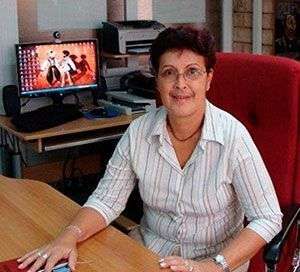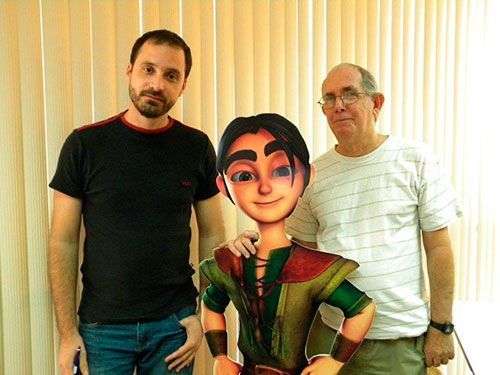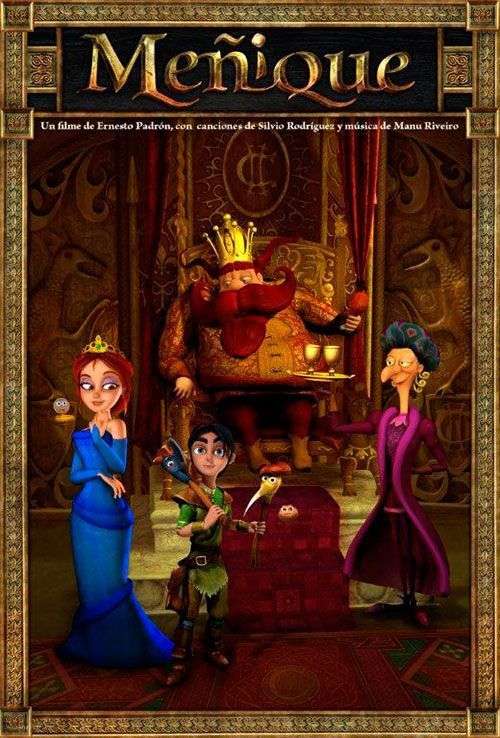After nine years, the first Cuban animated full film in 3D –Little finger, directed by Ernesto Padron–, will be premiered in the cinemas of the Caribbean island during the first week of July.
Little finger was a long and arduous process which seemed it would never come to an end. ICAIC’s (Cuban Film Institute by its acronym in Spanish) first experience in 3D turned it a school for its makers. It was an extended and hard path for the little hero to show his adventures to the public since in the seventies Tulio Raggi cherished the idea and asked Ernesto Padron to design the characters. The old project never materialized, although Padron always thought of doing it
The voices of the film have been recorded by Lieter Ledesma, Yoraisi Gómez, Manuel Marín, Corina Mestre, Carlos Ruiz de la Tejera and Osvaldo Doimeadiós and its soundtracks went by Pancho Amat, Edesio Alejandro, the National Symphonic Orchestra, Miriam Ramos, Anabel López and Ernesto Yoel Espinosa. Unlike many people might think, it wasn’t the lack of financing which slowed down the production.
We talked to Esther Girzel, director of ICAIC’s animation study and executive producer of the film; Ariel Blanco, its producer, and Padron, its scriptwriter.
Why did you choose to make this movie in 3D?

The magic mirror was the only character designed in 3D since the beginning given its complexity, but then the background didn’t match. After that, the idea was to make the characters in 2D, but that didn’t match either. Then, in 2008, we decided to make it all in 3D. Events led us that way. Little finger is a Finnish story, a French writer turned it into literature and Jose Martiadded a few elements to the story when he translated it for La Edad de Oro (The Golden Age). We also added a few elements, as free version we maintained the central plot but we made some arrangements so that this would be a stronger story because the Little finger we all know always succeeds, here he has to make a living, so the plot is more complex. There are new characters, diverse characterizations of other characters, and shifting figures. The script was enriched with allegories to the Cuban and Latin American cultures, as well as the production, which shows a mix of the Middles Ages with the colonial and contemporary periods in Cuba.
It is a beautiful story that shows us that knowledge is more powerful than strength, which made us embrace this dream and hold tight to it. We started to work on this idea in 2005, but with traditional animation in paper, we were just starting to learn how to work with computers in this new studio. The idea gradually evolved given the development of the digital industry which pointed us that we could also use computers for this endeavor, so we included digital animation, which speeded up the production. However, it went all the way around, it took us a lot longer. In the preparation stages we began to get to know 3D animation techniques and for the sake of innovation and update and relying on the human talent we started dreaming higher and decided to produce it in 3D in 2008. One year training was enough to include computers. It was still a 2D project but after getting in touch with and developing 3D products we wanted to mix several animation styles in the movie. That was our purpose, during its production we decided to make it entirely a 3D film.
Why has it taken so long?
The biggest setback was mastering the new technologies. 3D animation demanded more technology than we had available, so that delayed us considering the existing difficulties at that time to purchase the technology required. We had a financing from the Venezuela Cinema Village because the project had been enrolled in cooperation between the two countries. I was really upset about it, today I recall it in sadness for the time we lost and in joy because we finally made it. The funds were not released for the import, and this was a stressful situation. I didn’t talk openly about this earlier, not because it was a secret but because I would rather finish the movie and wait for it to be somehow close to its premier to explain what had really happened to the audience that had waited for it for so long. We had some trouble in getting the necessary equipment, which froze us for a year and a half. That process delayed and seriously affected the production of the film. Once we decided to do it in 3D in 2008, we started to train the staff, even without the necessary technology we started to recruit young people with aptitudes and knowledge from the theoretical point of view with the computers we had at hand and the software that allowed us to do 3D animations. The purchasing of the technology took about two years because there were certain difficulties in the country so we used that timefor doing some more training.
You made the most of time and Little finger became the first school on 3D animation in Cuba.
Little finger was a school since its conception, not just for animators but also for the whole team. It was an academy since its very beginning and it still is. We always knew that once this dream was finished, all the new producers that had joined it will continue to be our pillars for future projects. Many producers that participated in the production process also took part in the creation of many materials like La Luna en el jardín, which received several international awards, and El mundo sumergido, which have represented us internationally. We were lucky to have this school that trained animators on techniques and software.

How has the production process been throughout this time?
Ariel Blanco: Since 2008, when we decided to venture in 3D animations, we started with the selection and training of personnel. Then, there was the delay with the technology that would make the process easier and we continued on the improvement of the project and its participants. The Cuban Culture Ministry was very supportive. This kind of production demands a render process which has to do with the processing of the data which is rented rather than bought but Cuba couldn’t have it despite links and cooperation with the Cuban University on Computer Sciences and with foreign production companies. All these requirements and setbacks with the handling of software paved the way for a coproduction that would allow us to fulfill and guarantee the postproduction process which is really complex given its technical and technological requirements. Thus, in 2011, we talked with the Spanish company Ficcion Producciones and decided to sign the coproduction and by joining both talents and experiences we made up a very special team.
Ariel Blanco, producer and Ernesto Padron director of the film
A.B.This has been a challenge from the productive and the creative perspective. It has been a school and an odyssey and we have moved through different production stages where we had to learn the basics in order to overcome the obstacles. It was hard simply because it is the first 3D experience in the countryand our specialists lacked previous experiences in this field though they had flirted with it in short films; but in a full length film everything is different. Everything is different in planning, reviewing, organizing and monitoring in the different stages. We had to start from scratch, we learned a lot from our mistakes so we had to do it all over again so that it was ok. There are no books or anyone to explain you how to make a 3D movie. So everyone had to do some training, from directors to animators, with the support of the Cuban University for Computer Sciences.
And what can you tell us on the experience with foreign co-producers?
A.B. Regarding co-producers, we are very pleased with the work done. Every coproduction has to deal with some troubles, but when you go over the film you realize that the final result is the only thing that matters. Ficcion Producciones is settled in Santiago de Compostela, it is a serious production that watches over the quality of its products, which helped us gain confidence to move on with the project. As to large obstacles: communication between both parts with an ocean in between, slow internet connection was definitely a challenge. It was also difficult because they became part of the project when it was quite advanced.
E.H.We have the privilege that our government subsidizes the whole production and these studios, something that doesn’t occur in the rest of the world, so our co-producers, in addition to bringing in their funds, had to look for financing from cultural entities by presenting them the project and making them fall for it. The magic however is in Padron’s exceptional idea.
What do you think will stand out in the film?
E.H. The strength of images, obviously. It is a free Cuban version; even our foreign colleagues were amazed by the way of intertwining so many elements from our Cuban culture and identity. One of the biggest satisfactions is that of having Silvio Rodriguez and some beautiful songs he wrote specifically for this movie. Spanish musician Manu Rivero was in charge of incidental music, which was complemented with Silvio’s so we are very lucky. Little finger was also a challenge because it is difficult to work in the distance from Cuba mainly due to the slow internet connection and for that we would like to highlight the work by Cubarte’s professionals, who despite the connection difficulties worked really hard to help us exchange materials in this coproduction in the distance.
E.P.In addition to music and visual elements, I would like to draw attention to the script, which was added some new elements that were not included in the original. We made a sketch of the animated script to test it among children and it was accepted. We changed the original version but then we found out it was still effective, that’s the good thing about testing the script. If we hadn’t had so many troubles we would have done it even better, though we are satisfied, but it is a fact that the next projects will have higher quality.
A.B.It is a high quality film, which is something we are not used to in terms of national productions. We made our best efforts because we wanted to make a good film and I believe we succeeded.
How have you planned its distribution?
It will be premiered this summer, as usual in the Chaplin Cinema and then it will be screened in every movie theater in the country. We are working hard to get a merchandising before the premier, which would be interesting for the audience considering the significance of the first Cuban 3D film for the nation. The movie portrays wonderful colors which make images more beautiful. We are working with a German sales agent who is taking the necessary steps to place it in international events and festivals looking for new markets. We are also handling negotiations through the Spanish producers. There are large possibilities for this movie to be bought for some markets. ICAIC’s producer agency is also making market moves in Ibero-America mostly and the German sales agent is helping us in the rest of the world. ICAIC’s purpose it to launch the DVD as soon as possible so that it can be bought in parallel with the premier. It will be a beautiful material worth acquiring for the additional materials it includes which are as beautiful as the movie.
Does the movie end here or will it continue?
E.P. I’m working on a medium length film that includes scenes that are not seen in the movie, it is some sort of what you didn’t see, things that happened to the characters in moments that were not recorded for the film in order to produce some kind of saga.











